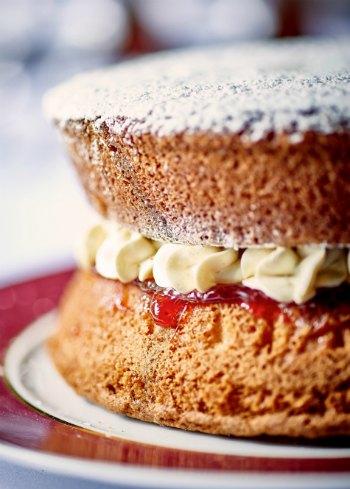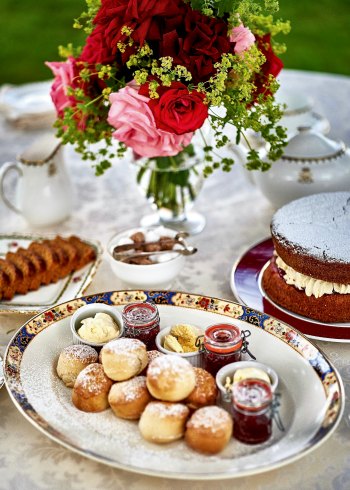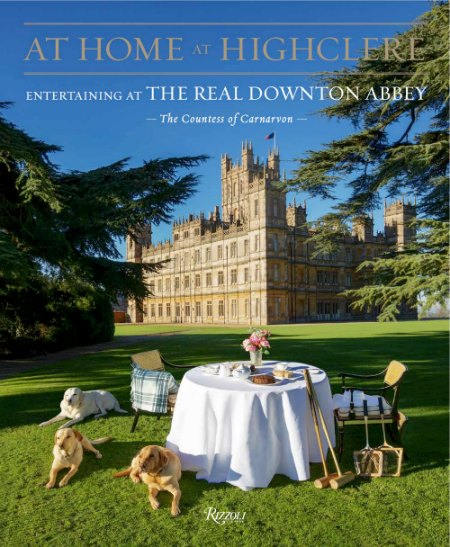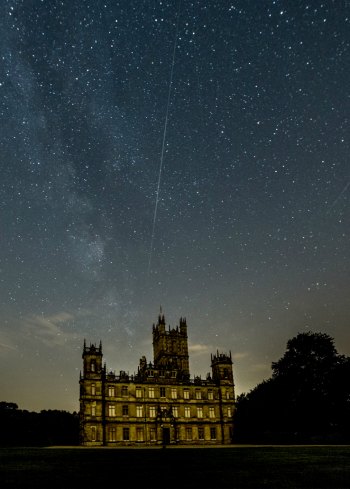‘At Home at Highclere – Entertaining at THE REAL DOWNTON ABBEY’ by The Countess of Carnarvon
Many of us are still yearning for more episodes of our beloved Downton Abbey. Although the television series has concluded, we can still get our fix of entertaining history, stories and delicious recipes from Highclere Castle. The Countess of Carnarvon has graciously shared an exclusive preview of her new book At Home at Highclere – Entertaining At The Real Downton Abbey which includes a book excerpt and a two recipes for Highclere’s Victoria Sponge Cake and Scones. A special thank you to Ellen Easton, Afternoon Tea and Etiquette expert for collaborating with us on this exciting book preview.
Be sure to check out Ellen Easton’s article Teatime at Highclere Castle- The Real Downton Abbey and enjoy more of Ellen Easton’s Tea Travels™ articles and recipes.
Learn about the History of English High Tea and more delicious Afternoon Tea Recipes.
Highclere Castle photos and all photo images by David Griffen©All Rights Reserved
Written by the current lady of the manor, this book gives complete access to the world-renowned historic country house and showcases the art of entertaining, past and present. Highclere Castle, famed as the setting for Downton Abbey, is the epitome of how we imagine the perfect English country house. Long the Carnarvon family’s ancestral country seat, Highclere has welcomed royalty, statesmen, and notables from the worlds of business, academia, and the arts for shooting parties, elegant fêtes, and celebrations in the grand style.
 Lady Fiona Carnarvon, the current chatelaine, invites readers inside Highclere, past and present, as she describes how to entertain in the style of a stately English country house: the etiquette of the invitation, multi-course meals, correct seating arrangements, proper attire, setting the table. She delves into family archives to highlight four real-life historic weekend parties over a seventy-year period during which Highclere hosted an ever-changing cast of notable figures—including Benjamin Disraeli and the Prince of Wales—exploring how society and entertaining changed decade by decade. Complete with gorgeous full-color photography of Highclere’s rooms and punctuated by charming archival images, the book explores changing menus, fashionable cocktails of the day, and includes, where practical, adaptations for recipes which can be used for entertaining in the present day. Be sure to pick up a copy At Home at Highclere – Entertaining At The Real Downton Abbey. Available at US bookstores on June 20th or Order online at Amazon.
Lady Fiona Carnarvon, the current chatelaine, invites readers inside Highclere, past and present, as she describes how to entertain in the style of a stately English country house: the etiquette of the invitation, multi-course meals, correct seating arrangements, proper attire, setting the table. She delves into family archives to highlight four real-life historic weekend parties over a seventy-year period during which Highclere hosted an ever-changing cast of notable figures—including Benjamin Disraeli and the Prince of Wales—exploring how society and entertaining changed decade by decade. Complete with gorgeous full-color photography of Highclere’s rooms and punctuated by charming archival images, the book explores changing menus, fashionable cocktails of the day, and includes, where practical, adaptations for recipes which can be used for entertaining in the present day. Be sure to pick up a copy At Home at Highclere – Entertaining At The Real Downton Abbey. Available at US bookstores on June 20th or Order online at Amazon.
AT HOME AT HIGHCLERE
Entertaining at The Real Downton Abbey
By The Countess of Carnarvon
“Highclere works hard to steer a steady course in today’s world, but the Castle was built for entertainment and pleasure, for convivial weekends. I hope this book gives a glimpse inside a great house, with mouth-watering recipes, eye-catching photographs and fascinating stories about some of the remarkable people who have stayed here.” – Lady Carnarvon
Highclere Castle is one of the most famous historic houses in the world. Throughout the centuries, Highclere has welcomed Royalty, Statesmen, Egyptologists, and pioneers of technology along with men and women from the worlds of music, art and letters. The etiquette of the invitation, the balance of guests at a weekend house party, their placement at dinners, and the entertainment of friends, as well as the domestic management required to execute the perfect occasion, have all preoccupied successive generations of châtelaines. In AT HOME AT HIGHCLERE: ENTERTAINING AT THE REAL DOWNTON ABBEY, the 8th Countess of Carnarvon invites you to enjoy five real weekends at Highclere from the mid-19th Century to the present day; Disraeli’s reform cabinet in 1866, a literary weekend with Henry James in 1886, a visit from the Prince of Wales in 1895, a musical Easter with Malcolm Sargent in 1935, and a life in the weekend of Highclere today. Lady Carnarvon tells the stories of the great and the good, the art of hosting through the ages, and, most critically the delicious recipes to suit every occasion – from the crowd-pleasing Highclere Loin of Venison for a weekend treat or Summer Pudding, a favorite of Lord Carnarvon and his cricket XI.
AT HOME AT HIGHCLERE is a rich compendium of stories and recipes from a building that is not just a castle but a home… and an extraordinary one at that.
About the Author: Fiona, 8th Countess of Carnarvon, is the wife of Geordie, 8th Earl of Carnarvon.
She is an alumna of St Andrews University, a former auditor for Coopers & Lybrand accountants and created her own clothes brand in the 1990s. She and her husband and son live ‘quietly’ with seven dogs, too many horses, a brood of chickens, a pet rabbit and a sheep, as well as a number of bee hives. Together, they manage a range of businesses at Highclere Castle, home of the worldwide television drama Downton Abbey. Fascinated by the history of the people as well as the Castle at Highclere, Lady Carnarvon has written two New York Times bestsellers: Lady Almina and the Real Downton Abbey: The Lost Legacy of Highclere (2011) and Lady Catherine and the Real Downton Abbey (2013).
© AT HOME AT HIGHCLERE: Entertaining at The Real Downton Abbey, The Countess of Carnarvon, Rizzoli New York, 2017. “The Real Downton Abbey” is a trade mark of Carnival Film and Television Limited. This book has been produced under licence from Carnival Film and Television Limited.
Available at U.S. bookstores on June 20th or Order online at Amazon.
Highclere Castle Victoria Sponge Cake Recipe
Preparation Time: 15 minutes
Baking Time: 25 minutes, Total Cooking Time: 50 minutes
Serves: 10
 Apparently, as a child, Queen Victoria was not allowed to eat sweet things very often, but during her reign the practice of taking afternoon tea was popularized and a little sweet something to sustain the Queen and her guests in the late afternoon became de rigueur. Thus the Victoria sponge or Victoria sandwich cake was named and makes for a delicious addition to afternoon tea.
Apparently, as a child, Queen Victoria was not allowed to eat sweet things very often, but during her reign the practice of taking afternoon tea was popularized and a little sweet something to sustain the Queen and her guests in the late afternoon became de rigueur. Thus the Victoria sponge or Victoria sandwich cake was named and makes for a delicious addition to afternoon tea.
Ingredients:
4 medium eggs, at room temperature
2 sticks softened unsalted butter, plus extra for greasing
1 cup superfine sugar, (also known as caster sugar)
1 3/4 cups self-rising flour*
2 level teaspoons baking powder
4 1/4 cups heavy whipping cream (also known as double cream)
2/3 cup strawberry jam
Powdered Sugar for dusting
*You can substitute Bisquick baking mix. Self-rising flour is excellent to use for quick breads, biscuits, and pancakes. To make your own self-rising flour use the following ratio mixture: 1 cup all purpose flour, 1 1/2 teaspoons baking powder, 1/4 teaspoon salt. Leftover Self-rising flour mix can be stored in an airtight container in cool, dark place for up to 1 year.
Directions:
Preheat the oven to 350° degrees F
Grease and line the base of 2 × 20cm (8-inch) sandwich tins. Break the eggs into a large mixing bowl. Add the butter, sugar, flour, and baking powder and mix everything together until well combined. The easiest way to do this is with a hand-held electric mixer or a stand mixer, but you can use a wooden spoon. As soon as everything is blended together, stop mixing. The batter should easily fall off a spoon.
Divide the mixture evenly between the tins and gently smooth the surface of the batter. Place the tins on the middle shelf of the oven and bake for 25 minutes. Don’t open the oven door during the cooking time or the cakes will sink. The cakes are done when they are golden-brown and coming away from the edge of the tins and a knife inserted into the middle of the cakes comes out clean.
Remove from the oven and set aside to cool in their tins for 5 minutes before turning the cakes out onto a wire rack. Remove the lining paper.
Whisk the cream in a bowl until it forms soft peaks.
When the cakes are completely cool, spread one cake with lots of thick, delicious jam, then pipe (or spread) the whipped cream over the top. Sandwich the cakes together and finish by dusting the top of the cake with a little icing sugar.
Serves: 10
Lady Carnarvon’s Scones Recipe
Preparation Time: 20 minutes
Baking Time: 10 minutes, Total Cooking Time: 30 minutes
Yields: 6 scones
 Originally made with unleavened oats and cooked on a griddle, scones today are generally sweetened and served with clotted cream and jam. In Devon they are spread with the cream first and then jam, and in Cornwall it is jam first and then cream – the choice is yours! The preferred pronunciation is equally contentious, as this rhyme makes plain:
Originally made with unleavened oats and cooked on a griddle, scones today are generally sweetened and served with clotted cream and jam. In Devon they are spread with the cream first and then jam, and in Cornwall it is jam first and then cream – the choice is yours! The preferred pronunciation is equally contentious, as this rhyme makes plain:
‘I asked the maid in dulcet tone
To order me a buttered scone;
The silly girl has been and gone
And ordered me a buttered scone.’
The mixture can be made in advance and kept in a container in the fridge. The secret to good scones is that the butter and milk used are cold, the dough is handled as little as possible, and that once cooked and cooling they are wrapped in a tea towel. Dried fruit such as sultanas or cranberries can be added just before the milk.
Ingredients:
1 3/4 cups self-rising flour, plus extra for dusting*
1 teaspoon salt, divided
1 teaspoon baking powder
4 tablespoons chilled unsalted butter, cubed
2 tablespoons superfine sugar, (also known as caster sugar)
1 medium egg, beaten
2/3 cup chilled whole milk
* You can substitute Bisquick baking mix. Self-rising flour is excellent to use for quick breads, biscuits, and pancakes. To make your own self-rising flour use the following ratio mixture: 1 cup all purpose flour, 1 1/2 teaspoons baking powder, 1/4 teaspoon salt. Leftover Self-rising flour mix can be stored in an airtight container in cool, dark place for up to 1 year.
Directions:
Preheat the oven to 450° degrees F
Dust a baking tray with flour and place it in the fridge.
Sift the flour, 1/2 teaspoon salt and baking powder into a mixing bowl. Set aside remaining salt for later use. Rub the butter into the flour and baking powder with your fingertips until the mixture resembles fine breadcrumbs, then stir in the sugar.
Add the egg to the milk and pour just enough of it into the flour mixture to form a sticky, soft dough. You may have about 3 tablespoons left. Reserve the remaining milk and egg mixture for later.
Turn the dough out onto a floured board or worktop and quickly and gently shape it into a round about 3/4-inches thick. Handle the dough as little as possible and cut out 6 scones cleanly with a plain 2¼ inches floured cutter. Place rounds on the chilled, floured baking tray and brush each scone lightly with some of the remaining milk/egg mixture. Bake in the oven for 9–10 minutes until golden brown and well risen. Put a clean tea towel on a wire rack. Lift the scones off the baking tray with a palette knife, transfer to the tea towel and wrap the towel around the scones. These scones are best eaten warm, soon after baking, and are fabulous with clotted cream, and raspberry or strawberry jam. YIelds 6 scones
Tearooms Recipe
Yields: about 25 scones
Baking Time: 17 minutes
The scones that we serve in the Castle tearooms and for our formal afternoon teas are baked to a different recipe by our chef, Paul Brooke-Taylor.
Ingredients:
2 pounds all-purpose flour
1 stick (1/2 cup) softened unsalted butter, cubed
2/3 cups superfine sugar, (also known as caster sugar)
51/4 tablespoon baking powder
1 medium egg
1 2/3 cup whole milk
1/2 cup golden raisins or sultanas
Directions:
Preheat the oven to 350° degrees F
Dust two baking trays with flour and place in the fridge.
Sift the flour and baking powder into a mixing bowl. Rub the butter into the flour and baking powder with your fingertips until the mixture resembles fine breadcrumbs, then stir in the sugar.
Add the egg to the milk and pour just enough of it into the flour mixture to form a sticky, soft dough (you may have about 3 tablespoons left). Reserve the remaining milk and egg mixture for later. Add the golden raisins to the dough and mix in to evenly distribute.
Turn the dough out onto a floured board or worktop and quickly and gently shape it into a round about 3/4 inches thick. Handle the dough as little as possible and cut out 6 scones cleanly with a plain 2 1/2 inches floured cutter. Place rounds on the chilled, floured baking tray and brush each scone lightly with some of the remaining milk/egg mixture. Bake in the oven for 17 minutes until golden brown and well risen. Put a clean tea towel on a wire rack. Lift the scones off the baking tray with a palette knife, transfer to the tea towel and wrap the towel around the scones. These scones are best eaten warm, soon after baking, and are fabulous with clotted cream, and raspberry or strawberry jam. YIelds 25 scones
Categories:
British Recipes Ellen Easton's Tea Travels™ Articles Historical Cakes Scones Tea Cakes Tea Travels™ Cakes Tea Travels™ Scones White Cakes


